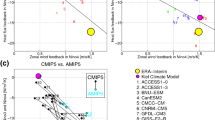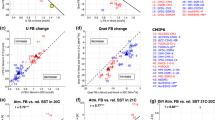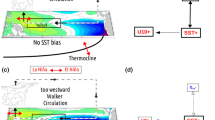Abstract
We investigate the dependence of ENSO atmospheric feedbacks on the mean-state in a perturbed atmospheric physics ensemble with the Kiel Climate Model (KCM) and in CMIP5 models. Additionally, uncoupled simulations are conducted with the atmospheric component of the KCM to obtain further insight into the mean-state dependence. It is found that the positive zonal wind feedback and the negative heat flux feedback, with the short-wave flux as dominant component, are strongly linearly related through sea surface temperature (SST) and differences in model physics are less important. In observations, strong zonal wind and heat flux feedbacks are caused by a convective response in the western central equatorial Pacific (Niño4 region), resulting from an eastward (westward) shift of the rising branch of the Walker Circulation (WC) during El Niño (La Niña). Many state-of-the-art climate models exhibit an equatorial cold SST bias in the Niño4 region, i.e. are in a La Niña-like mean-state. Therefore they simulate a too westward located rising branch of the WC (by up to 30°) and only a weak convective response. Thus, the position of the WC determines the strength of both the amplifying wind and usually damping heat flux feedback, which also explains why biases in these two feedbacks partly compensate in many climate models. Furthermore, too weak atmospheric feedbacks can cause quite different ENSO dynamics than observed, while enhanced atmospheric feedbacks lead to a substantial improvement of important ENSO properties such as seasonal ENSO phase locking and asymmetry between El Niño and La Niña. Differences in the mean-state SST are suggested to be a major source of ENSO diversity in current climate models.
















Similar content being viewed by others
References
An SI, Jin FF (2004) Nonlinearity and asymmetry of ENSO. J Clim 17:2399–2412. doi:10.1175/1520-0442(2004)017<2399:NAAOE>2.0.CO;2
An S-I, Ham Y-G, Kug J-S, Jin F-F, Kang I-S (2005) El Niño–La Niña asymmetry in the coupled model intercomparison project simulations*. J Clim 18:2617–2627
Bayr T, Dommenget D (2013) The tropospheric land–sea warming contrast as the driver of tropical sea level pressure changes. J Clim 26:1387–1402. doi:10.1175/JCLI-D-11-00731.1
Bayr T, Dommenget D, Martin T, Power SB (2014) The eastward shift of the Walker Circulation in response to global warming and its relationship to ENSO variability. Clim Dyn 43:2747–2763. doi:10.1007/s00382-014-2091-y
Bellenger H, Guilyardi E, Leloup J, Lengaigne M, Vialard J (2014) ENSO representation in climate models: from CMIP3 to CMIP5. Clim Dyn 42:1999–2018. doi:10.1007/s00382-013-1783-z
Bjerknes J (1969) Atmospheric teleconnections from the Equatorial Pacific. Mon Weather Rev 97:163–172
Burgers G, Stephenson DB (1999) The “normality” of El Niño. Geophys Res Lett 26:1027–1030
Davey M et al (2002) STOIC: a study of coupled model climatology and variability in tropical ocean regions. Clim Dyn 18:403–420. doi:10.1007/s00382-001-0188-6
DiNezio PN et al (2012) Mean climate controls on the simulated response of ENSO to increasing greenhouse gases. J Clim 25:7399–7420. doi:10.1175/JCLI-D-11-00494.1
Dommenget D (2010) The slab ocean El Niño. Geophys Res Lett 37:L20701. doi:10.1029/2010GL044888
Dommenget D (2016) A simple model perturbed physics study of the simulated climate sensitivity uncertainty and its relation to control climate biases. Clim Dyn 46:427–447. doi:10.1007/s00382-015-2591-4
Dommenget D, Yu Y (2016) the seasonally changing cloud feedbacks contribution to the ENSO seasonal phase-locking. Clim Dyn., 1–12, doi:10.1007/s00382-016-3034-6
Dommenget D, Bayr T, Frauen C (2013) Analysis of the non-linearity in the pattern and time evolution of El Niño southern oscillation. Clim Dyn 40:2825–2847. doi:10.1007/s00382-012-1475-0
Dommenget D, Haase S, Bayr T, Frauen C (2014) Analysis of the Slab Ocean El Nino atmospheric feedbacks in observed and simulated ENSO dynamics. Clim Dyn 42:3187–3205. doi:10.1007/s00382-014-2057-0
Frauen C, Dommenget D (2010) El Niño and La Niña amplitude asymmetry caused by atmospheric feedbacks. Geophys Res Lett 37:L18801. doi:10.1029/2010GL044444
Guilyardi E et al (2004) Representing El Niño in coupled ocean–atmosphere GCMS: the dominant role of the atmospheric component. J Clim 17:4623–4629. doi:10.1175/JCLI-3260.1
Guilyardi E et al (2009a) Atmosphere feedbacks during ENSO in a coupled GCM with a modified atmospheric convection scheme. J Clim 22:5698–5718. doi:10.1175/2009JCLI2815.1
Guilyardi E, Wittenberg A, Fedorov A, Collins M, Wang C, Capotondi A, van Oldenborgh GJ, Stockdale T (2009b) Understanding El Niño in ocean-atmosphere general circulation models: progress and challenges. Bull Am Meteorol Soc 90:325–340. doi:10.1175/2008BAMS2387.1
Harlaß J, Latif M, Park W (2015) Improving climate model simulation of tropical Atlantic sea surface temperature: the importance of enhanced vertical atmosphere model resolution. Geophys Res Lett 42:2401–2408. doi:10.1002/2015GL063310
Jin FF, Kim ST, Bejarano L (2006) A coupled-stability index for ENSO. Geophys Res Lett 33:2–5. doi:10.1029/2006GL027221
Kim D, Kug J-S, Kang I-S, Jin F-F, Wittenberg AT (2008) Tropical Pacific impacts of convective momentum transport in the SNU coupled GCM. Clim Dyn 31:213–226. doi:10.1007/s00382-007-0348-4
Kim ST, Cai W, Jin F-F, Santoso A, Wu L, Guilyardi E, An S-I (2014a) Response of El Niño sea surface temperature variability to greenhouse warming. Nat Clim Change 4:786–790. doi:10.1038/nclimate2326
Kim ST, Cai W, Jin FF, Yu JY (2014b) ENSO stability in coupled climate models and its association with mean state. Clim Dyn 42:3313–3321. doi:10.1007/s00382-013-1833-6
Latif M, Keenlyside NS (2009) El Niño/Southern Oscillation response to global warming. Proc Natl Acad Sci 106:20578–20583
Lloyd J, Guilyardi E, Weller H, Slingo J (2009) The role of atmosphere feedbacks during ENSO in the CMIP3 models. Atmos Sci Lett 10:170–176. doi:10.1002/asl.227
Lloyd J, Guilyardi E, Weller H, Slingo J (2011) The role of atmosphere feedbacks during ENSO in the CMIP3 models. Part II: using AMIP runs to understand the heat flux feedback mechanisms. Clim Dyn 37:1271–1292. doi:10.1175/JCLI-D-11-00178.1
Lloyd J, Guilyardi E, Weller H, Slingo J (2012) The role of atmosphere feedbacks during ENSO in the CMIP3 models. Part III: the shortwave flux feedback. J Clim 25:4275–4293. doi:10.1175/JCLI-D-11-00178.1
Madec G (2008) NEMO ocean engine. Note du Pole modélisation 27, Inst. Pierre-Simon Laplace, p 193
Madec G, Delecluse P, Imbard M, Lévy C (1998) OPA 8.1 ocean general circulation model manual. Note du Pole modélisation 11, Inst. Pierre-Simon Laplace, p 91
Mauritsen T et al (2012) Tuning the climate of a global model. J Adv Model Earth Syst. doi:10.1029/2012MS000154
Meehl GA et al (2007a) Global Climate Projections. Climate change 2007: the physical science basis. Contribution of Working Group I to the Fourth Assessment Report of the Intergovernmental Panel on Climate Change. Cambridge University Press, Cambridge, pp 747–846
Meehl GA, Covey C, Delworth T, Latif M, McAvaney B, JFB Mitchell, Stouffer RJ, Taylor KE (2007b) The WCRP CMIP3 multimodel dataset: a new era in climate change research. Bull Am Meteorol Soc 88:1383. doi:10.1175/BAMS-88-9-1383
Neelin JD, Battisti DS, Hirst AC, Jin F-F, Wakata Y, Yamagata T, Zebiak SE (1998) ENSO theory. J Geophys Res 103:14261. doi:10.1029/97JC03424
Park W, Keenlyside NS, Latif M, Ströh A, Redler R, Roeckner E, Madec G (2009) Tropical Pacific climate and its response to global warming in the Kiel climate model. J Clim 22:71–92. doi:10.1175/2008JCLI2261.1
Philander S (1990) El Niño, La Niña, and the southern oscillation. Academic Press, San Diego, p 293
Rayner NA, Parker DE, Horton EB, Folland CK, Alexander LV, Rowell DP, Kent EC, Kaplan A (2003) Global analyses of sea surface temperature, sea ice, and night marine air temperature since the late nineteenth century. J Geophys Res 108:4407
Roeckner E et al (2003) The atmospheric general circulation model ECHAM5. PART I: model description, Report 349. Max Planck Institute for Meteorology, Hamburg, p 140
Rossow WB, Schiffer AR (1999) Advances in understandig clouds from ISCCP. Bull Am Meteorol Soc 80:2261–2287. doi:10.1175/1520-0477(1999)080<2261:AIUCFI>2.0.CO;2
Schneider EK (2002) Understanding differences between the equatorial Pacific as simulated by two coupled GCMs. J Clim 15:449–469. doi:10.1175/1520-0442(2002)015<0449:UDBTEP>2.0.CO;2
Simmons A, Uppala S, Dee D, Kobayashi S (2007) ERA-Interim: new ECMWF reanalysis products from 1989 onwards. ECMWF Newsl 110:25–35
Stocker T, Qin D, Plattner G, Tignor M, Allen S (2013) IPCC 2013: climate change 2013: the physical science basis. Contribution of Working Group I to the Fifth Assessment Report of the Intergovernmental Panel on Climate Change. Cambridge University Press, New York, p 1535
Sun DZ, Yu Y, Zhang T (2009) Tropical water vapor and cloud feedbacks in climate models: a further assessment using coupled simulations. J Clim 22:1287–1304. doi:10.1175/2008JCLI2267.1
Taylor KE, Stouffer RJ, GA Meehl (2012) An overview of CMIP5 and the experiment design. Bull Am Meteorol Soc 93:485–498. doi:10.1175/BAMS-D-11-00094.1
Trenberth KE (1997) The definition of El Niño. Bull Am Meteorol Soc 78:2771–2778
Uppala SM et al (2005) The ERA-40 re-analysis. Q J R Meteorol Soc 131:2961–3012. doi:10.1256/qj.04.176
Van Oldenborgh GJ, Philip S, Collins M (2005) El Nino in a changing climate: a multi-model study. Ocean Sci 1:81–95
Vannière B, Guilyardi E, Madec G, Doblas-Reyes FJ, Woolnough S (2013) Using seasonal hindcasts to understand the origin of the equatorial cold tongue bias in CGCMs and its impact on ENSO. Clim Dyn 40:963–981. doi:10.1007/s00382-012-1429-6
Vinukollu RK, Meynadier R, Sheffield J, Wood EF (2011) Multi-model, multi-sensor estimates of global evapotranspiration: climatology, uncertainties and trends. Hydrol Process 25:3993–4010. doi:10.1002/hyp.8393
Wang C, Picaut J (2004) Understanding ENSO physics—a review. Earth’s Climate, American Geophysical Union, New York, pp 21–48
Wang C, Deser C, Yu J (2012) El Niño and Southern Oscillation (ENSO): a review. Coral Reefs Eastern Pacific
Wengel C, Latif M, Park W, Harlaß J, Bayr T (2017) Controls of seasonal ENSO phase locking in the Kiel climate model: the importance of the equatorial cold sea surface temperature bias. Clim Dyn. doi:10.1007/s00382-017-3648-3
Xie P, Arkin PA (1997) Global precipitation: a 17-year monthly analysis based on gauge observations, satellite estimates, and numerical model outputs. Bull Am Meteorol Soc 78:2539–2558. doi:10.1175/1520-0477(1997)078<2539:GPAYMA>2.0.CO;2
Yu B, Zwiers FW (2010) Changes in equatorial atmospheric zonal circulations in recent decades. Geophys Res Lett 37:L05701
Yu L, Jin X, Weller RA (2008) Multidecade global flux datasets from the objectively analyzed air-sea fluxes (OAFlux) project: latent and sensible heat fluxes, ocean evaporation, and related surface meteorological variables. Oa-2008-01. doi:10.1007/s00382-011-1115-0
Yu B, Zwiers FW, Boer GJ, Ting MF (2012) Structure and variances of equatorial zonal circulation in a multimodel ensemble. Clim Dyn. doi:10.1007/s00382-012-1372-6
Zhang T, Sun D-Z (2013) ENSO Asymmetry in CMIP5 models. J Clim 27:4070–4093. doi:10.1175/JCLI-D-13-00454.1
Acknowledgements
We acknowledge the World Climate Research Program’s Working Group on Coupled Modeling, the individual modeling groups of the Climate Model Intercomparison Project (CMIP3 and CMIP5), the UK Met Office, ECMWF, NOAA, ISCCP and Woods Hole Oceanographic Institution for providing the data sets. The climate model integrations of the KCM and ECHAM5 were performed at the Computing Centre of Kiel University. This work was supported by the SFB 754 “Climate-Biochemistry Interactions in the tropical Ocean”, the European Union’s InterDec project, the ARC Centre of Excellence for Climate System Science (Grant CE110001028), the ARC project “Beyond the linear dynamics of the El Niño Southern Oscillation” (Grant DP120101442). This is a contribution to the Cluster of Excellence “The Future Ocean” at the University of Kiel.
Author information
Authors and Affiliations
Corresponding author
Rights and permissions
About this article
Cite this article
Bayr, T., Latif, M., Dommenget, D. et al. Mean-state dependence of ENSO atmospheric feedbacks in climate models. Clim Dyn 50, 3171–3194 (2018). https://doi.org/10.1007/s00382-017-3799-2
Received:
Accepted:
Published:
Issue Date:
DOI: https://doi.org/10.1007/s00382-017-3799-2




